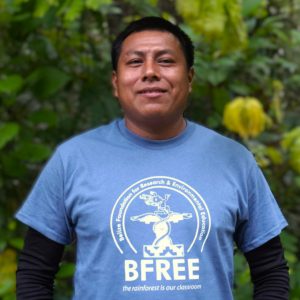Non-Proft
Rocento Pau joins BFREE as Administrative Assistant
My Name is Rocento Pau. I was born and raised in Sunday Wood Village, which is in the southern district of Toledo. I am a Ketchi maya. I grew up working in the forest with my father for a living. I am a person who takes each opportunity as a learning experience. I love nature.…
Read MoreIntroducing New Hospitality Staff at BFREE
Two new faces greet BFREE visitors in 2023. We are happy to introduce Pedro Witz, Office and Hospitality Coordinator, and Mario Teul, Tour Guide and Educator. (Header photo of Mario Teul with students from Kutztown University by Chris Habeck.) Pedro Witz Pedro Witz was born in Puerto Barrios Guatemala in 1987. Shortly after, his parents migrated…
Read MoreFreshwater and Terrestrial Turtle Survey – Year Two
by Eric Munscher This year, we, members of the TSA – North American Freshwater Turtle Research Group (NAFTRG), had a team of ten people fly down to trap turtles on the BFREE private reserve in southern Belize. If you have never been to Belize, I highly recommend it. The country is beautiful and the people…
Read MoreGenetic Analysis of Dermatemys mawii
BFREE’s second Hicatee (Central American River Turtle) Health Assessment of 2022 took place on July 5 and 6. These dates were much earlier than normal because there was an opportunity to conduct a much-needed genetics study. Dr. Natalia Gallego Garcia traveled from Colombia to collect the samples that will be used for genetic analysis. With…
Read MoreSpring Health Assessment 2020
Between February 28th and March 1st, a total of 341 turtles (45 adults in the breeding population and 296 captive hatched animals) were assessed at the Hicatee Conservation and Research Center (HCRC). The primary purpose of the spring health assessment was to perform a basic exam of the overall health of the captive population at…
Read MoreLand Snail Workshop at BFREE
The first workshop on the Land Snails of Belize was led by biologists, Dan and Judy Dourson, and took place at the BFREE field station in late February. The workshop’s goal was to give participants an understanding of which snails can be found in southern Belize and to train them to identify land snails with…
Read MoreBirds, Chocolate, Forests, and Allegheny College
Allegheny College students pose for a photo at BFREE during the Birds, Chocolate, Forest Field Course in May 2019. Written By, Beth Choate, Ph.D.Associate Professor, Environmental Science and SustainabilityAllegheny College BFREE’s Birds, Chocolate and Forests course provided students with a real life example of the complexities of conservation within the rainforests of southern Belize. Through…
Read MoreBFREE Receives Porras Conservation Award
It’s not often international wildlife conferences hold their annual meeting so close to home. Fortunately, the International Herpetological Symposium (IHS) chose Belize City as the base for their 42nd gathering and we are so glad they did! The International Herpetological Symposium (IHS) provides a forum for the dissemination of information and research pertaining…
Read MoreHicatee Awareness Month 2018 Wrap Up
Hicatee Awareness Month 2018 The Hicatee turtle, a national treasure for Belize, is seriously under threat due to over-hunting for human consumption. Listed as critically endangered, Belize offers the highest chance for its survival. Because the Hicatee is in need of greater protection and innovative conservation actions, Turtle Survival Alliance and BFREE launched Hicateee Awareness Month, a country-wide awareness campaign…
Read MoreHicatee Awareness Month in the News
Hicatee Awareness Month in the News! HCRC Manager, Thomas Pop, Field Course Leader, Nelly Cadle, and Science & Education Fellow, Jaren Serano had the distinct honor of being interviewed about BFREE, the HCRC, and all things Hicatee on news outlets thoughout Belize during October. We are thrilled that the media helped in bringing positive attention to work…
Read More

